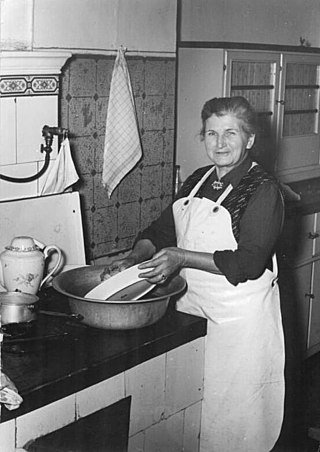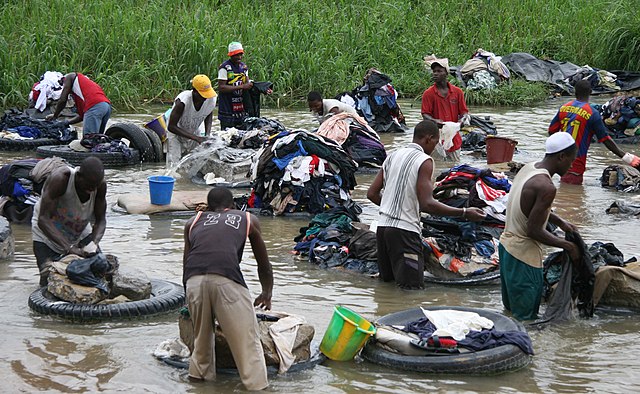Washing
Method of cleaning From Wikipedia, the free encyclopedia
Method of cleaning From Wikipedia, the free encyclopedia
Washing is a method of cleaning, usually with water and soap or detergent. Regularly washing and then rinsing both body and clothing is an essential part of good hygiene and health.[1][2][3]

Often people use soaps and detergents to assist in the emulsification of oils and dirt particles so they can be washed away. The soap can be applied directly, or with the aid of a washcloth or assisted with sponges or similar cleaning tools.
In social contexts, washing refers to the act of bathing, or washing different parts of the body, such as hands, hair, or faces. Excessive washing may damage the hair, causing dandruff, or cause rough skin/skin lesions.[4][5] Some washing of the body is done ritually in religions like Christianity and Judiasm, as an act of purification.
Washing can also refer to washing objects. For example, washing of clothing or other cloth items, like bedsheets, or washing dishes or cookwear. Keeping objects clean, especially if they interact with food or the skin, can help with sanitation. Other kinds of washing focus on maintaining cleanliness and durability of objects that get dirty, such washing one's car, by lathering the exterior with car soap, or washing tools used in a dirty process.

People wash themselves, or bathe periodically for religious ritual or therapeutic purposes[6] or as a recreational activity.
In Europe, some people use a bidet to wash their external genitalia and the anal region after using the toilet, instead of using toilet paper.[7] The bidet is common in predominantly Catholic countries where water is considered essential for anal cleansing.[8]
More frequent is washing of just the hands, e.g. before and after preparing food and eating, after using the toilet, after handling something dirty, etc. Hand washing is important in reducing the spread of germs.[9][10] Also common is washing the face, which is done after waking up, or to keep oneself cool during the day. Brushing one's teeth is also essential for hygiene and is a part of washing.
Ritual purification through washing includes acts like Maundy, a Christian ritual involving washing of the feet, or ceremonial washing in Judaism.


Bathing is the immersion of the body, wholly or partially, usually in water, but often in another medium such as hot air. It is most commonly practised as part of personal cleansing, and less frequently for relaxation or as a leisure activity. Cleansing the body may be solely a component of personal hygiene, but is also a spiritual part of some religious rituals. Bathing is also sometimes used medically or therapeutically, as in hydrotherapy, ice baths, or the mud bath.
People bathe in water at temperatures ranging from very cold to very hot, or in appropriately heated air, according to custom or purpose.
Where indoor heated water is available, people bathe more or less daily, at comfortable temperatures, in a private bathtub or shower. Communal bathing, such as that in hammams, sauna, banya, Victorian Turkish baths, and sentō, fulfils the same purpose, in addition to its often having a social function.
Ritual religious bathing is sometimes referred to as immersion. This can be required after sexual intercourse or menstruation (Islam and Judaism), or as baptism (Christianity).
By analogy, the term "bathing" is also applied to relaxing activities in which the participant "bathes" in the rays of the sun (sunbathing) or in outdoor bodies of water, such as in sea bathing or wild swimming.
Although there is sometimes overlap, as in sea bathing, most bathing is usually treated as distinct from more active recreations like swimming.Hand washing (or handwashing), also known as hand hygiene, is the act of cleaning one's hands with soap or handwash and water to remove viruses/bacteria/microorganisms, dirt, grease, and other harmful or unwanted substances stuck to the hands. Drying of the washed hands is part of the process as wet and moist hands are more easily recontaminated.[11][12] If soap and water are unavailable, hand sanitizer that is at least 60% (v/v) alcohol in water can be used as long as hands are not visibly excessively dirty or greasy.[13][14] Hand hygiene is central to preventing the spread of infectious diseases in home and everyday life settings.[15]
The World Health Organization (WHO) recommends washing hands for at least 20 seconds before and after certain activities.[16][17] These include the five critical times during the day where washing hands with soap is important to reduce fecal-oral transmission of disease: after using the toilet (for urination, defecation, menstrual hygiene), after cleaning a child's bottom (changing diapers), before feeding a child, before eating and before/after preparing food or handling raw meat, fish, or poultry.[18]
When neither hand washing nor using hand sanitizer is possible, hands can be cleaned with uncontaminated ash and clean water, although the benefits and harms are uncertain for reducing the spread of viral or bacterial infections.[19] However, frequent hand washing can lead to skin damage due to drying of the skin.[20] Moisturizing lotion is often recommended to keep the hands from drying out; dry skin can lead to skin damage which can increase the risk for the transmission of infection.[21]Hair washing is the cosmetic act of keeping hair clean by washing it. To remove sebum from hair, some apply a surfactant, usually shampoo (sometimes soap) to their hair and lather the surfactant with water. The surfactant is rinsed out with water along with the dirt that it bonds to.
Furthermore, there are dry shampoos; powders that remove sebum from hair by soaking it up prior to being combed out. People often use dry shampoo if they would like to postpone their hair wash or simply to save time.[22]
Hair wash and dry shampoo keep the hair healthy, add volume to the hair, remove dirt and odors, and remove oils from the scalp.Face washing, also known as facial cleanliness or face cleansing, is a form of washing in order remove dirt, germs, oil, debris, and any unwanted materials on the face, possibly with the use of soap or cleansing agent and water. These dirt or unwanted substances from cosmetic products and the environment are hardly soluble in water. The addition of face cleansing products in daily face washing can help effectively eliminate undesirable materials by breaking them down into smaller particles.





Laundry is the washing of clothing and other textiles,[24] and, more broadly, their drying and ironing as well. Laundry has been part of history since humans began to wear clothes, so the methods by which different cultures have dealt with this universal human need are of interest to several branches of scholarship.
Laundry work has traditionally been highly gendered, with the responsibility in most cultures falling to women (formerly known as laundresses or washerwomen). The Industrial Revolution gradually led to mechanized solutions to laundry work, notably the washing machine and later the tumble dryer. Laundry, like cooking and child care, is still done both at home and by commercial establishments outside the home.[25]
The word "laundry" may refer to the clothing itself, or to the place where the cleaning happens. An individual home may have a laundry room; a utility room includes, but is not restricted to, the function of washing clothes. An apartment building or student hall of residence may have a shared laundry facility such as a tvättstuga. A stand-alone business is referred to as a self-service laundry (launderette in British English or laundromat in North American English).




Seamless Wikipedia browsing. On steroids.
Every time you click a link to Wikipedia, Wiktionary or Wikiquote in your browser's search results, it will show the modern Wikiwand interface.
Wikiwand extension is a five stars, simple, with minimum permission required to keep your browsing private, safe and transparent.